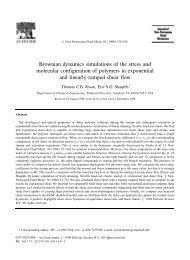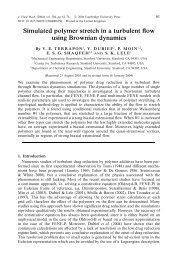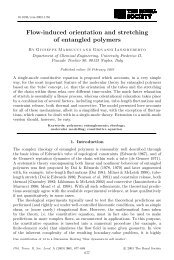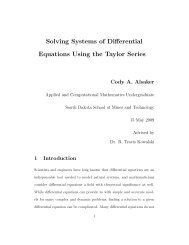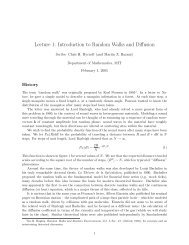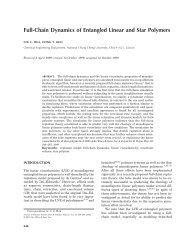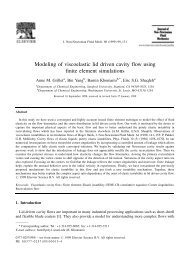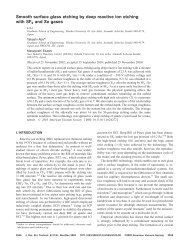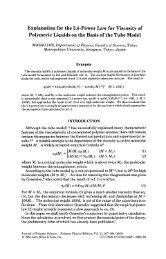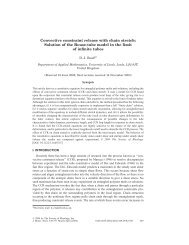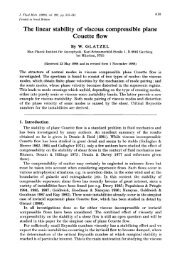A numerical study of the rheological properties of suspensions of ...
A numerical study of the rheological properties of suspensions of ...
A numerical study of the rheological properties of suspensions of ...
You also want an ePaper? Increase the reach of your titles
YUMPU automatically turns print PDFs into web optimized ePapers that Google loves.
182 M. B. Mackaplow and E. S. G. ShaqfehComparison <strong>of</strong> our <strong>numerical</strong> simulations to experiments and <strong>the</strong>oretical predictionsfor steady state shear and extensional viscosities also support <strong>the</strong> conclusionthat <strong>the</strong> semi-dilute suspension screening length is independent <strong>of</strong> <strong>the</strong> fibre orientationdistribution in <strong>the</strong> suspension. This conclusion is powerful since it allows oneto convert knowledge <strong>of</strong> <strong>the</strong> transient fibre orientation distribution in a suspensionto <strong>the</strong> transient <strong>rheological</strong> <strong>properties</strong> <strong>of</strong> <strong>the</strong> suspension. This is particularly valuablein a rapidly changing flow field where steady-state conditions are not reached sincedirect measurement <strong>of</strong> transient <strong>rheological</strong> <strong>properties</strong> are difficult.Slender-body <strong>the</strong>ory will faithfully capture <strong>the</strong> effect <strong>of</strong> fibre-fibre interactionson <strong>the</strong> hydrodynamic stress in an isotropic suspension for concentrations up tox A/5, beyond which it underestimates <strong>the</strong>ir effect. Interestingly, although <strong>the</strong>average steady-state closest approach distance between fibres in shear flow is muchlarger than for those in an isotropic suspension, <strong>the</strong> few fibres that make <strong>the</strong> dominantcontribution to <strong>the</strong> suspension stress experience closest approach distances that areapproximately <strong>the</strong> same as those in an isotropic suspension. Consequently, in suchflows <strong>the</strong> same upper concentration limit for <strong>the</strong> ability <strong>of</strong> slender-body <strong>the</strong>ory tocapture <strong>the</strong> full effect <strong>of</strong> fibre-fibre interactions is observed. This limit is presumablymuch higher in aligned <strong>suspensions</strong>, since for a given suspension concentration <strong>the</strong>average closest approach distance is much larger.Our algorithm can easily be modified to determine <strong>the</strong> sedimentation characteristics<strong>of</strong> fibre <strong>suspensions</strong>. This is done by changing <strong>the</strong> right-hand side <strong>of</strong> (8) to specifythat <strong>the</strong> net force exerted by a fibre on <strong>the</strong> fluid is equal to <strong>the</strong> gravitational bodyforce exerted on <strong>the</strong> fibre. Monte Carlo and dynamic studies <strong>of</strong> fibre sedimentationare in progress.The authors would like to acknowledge support for this work from both a PresidentialYoung Investigator Award, Grant No. CTS-90557284, to ESGS, as well asa Merck Fellowship to MBM. Computer resources (CRAY C90) were supplied by agrant from <strong>the</strong> San Diego Supercomputer Center. This material is based on worksupported by Cornell University through <strong>the</strong> National Science Foundation Grant No.DDM-9212582.Appendix. Calculations <strong>of</strong> <strong>the</strong> correction to <strong>the</strong> effective viscosity <strong>of</strong> a fibresuspension for two-body interactionsA.l. General developmentA method for calculating expressions for <strong>the</strong> effective viscosity in a random dispersion<strong>of</strong> rigid fibres in a Newtonian fluid which accounts for multi-body interactions hasbeen carefully presented by Shaqfeh & Fredrickson (1990). We shall refer to thispublicaton for <strong>the</strong> details and only outline <strong>the</strong> ma<strong>the</strong>matical steps necessary to derive<strong>the</strong> results quoted in 54 - namely <strong>the</strong> first correction to <strong>the</strong> predicted effective viscosity<strong>of</strong> a fibre solution in <strong>the</strong> dilute limit which accounts for two-body interactions.The general <strong>the</strong>ory developed by Shaqfeh & Fredrickson (1990) for <strong>the</strong> wavenumberdependentpropagator, Gjk(q) in <strong>suspensions</strong> <strong>of</strong> randomly positioned fibres can besummarized in <strong>the</strong> following set <strong>of</strong> integral equations :



